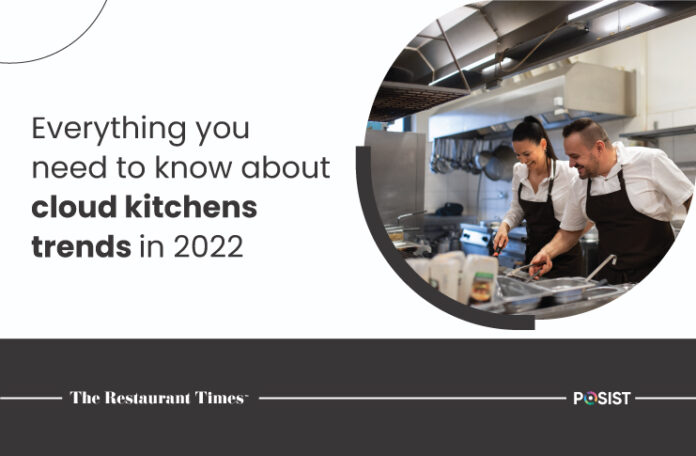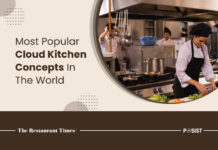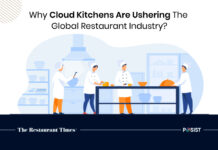Cloud kitchens were popular even before the pandemic, but they have grown more profitable and can function in a quarter of the usual restaurant size. Also called ghost kitchens enable restaurants to deliver directly to customers’ homes while operating at a fraction of the space required by typical restaurants. This helps them utilize resources more effectively by streamlining kitchen workflows in ways a restaurant can’t.
Before Covid-19, there had been a clear distinction between delivery-centric and dine-in brands. However, this will not be the scenario in the future. According to a RedSeer Management Consulting analysis, cloud kitchens would be worth $2 billion in India by 2024, up from $400 million in 2019. So what are cloud kitchens? And what are some trends you should be on a look out for? Let’s find out.
What Is A Cloud Kitchen?
A cloud kitchen, sometimes known as a ‘ghost kitchen’ or’ virtual kitchen’” is a contemporary culinary environment that gives food businesses the equipment and resources to cook food for delivery and takeout.
It is a kitchen that provides food but does not serve it on-site. The service is provided by delivery personnel, and modern businesses frequently rely on technology, usually in the form of an app.
There are several benefits to using a cloud kitchen. For starters, it requires lesser investment; it has more growth prospects, it increases the efficiency of your staff, and you can operate different brands beneath one roof. Unlike traditional brick-and-mortar facilities, cloud kitchens allow food entrepreneurs to make and transport dishes with minimal possible overheads.
Although, royalty, discounts, and increased staff and compliance costs, among other things, become critical for cloud kitchens to flourish.
Advantages of Cloud Kitchen
Restaurants are notorious for bearing hefty operating and overhead costs. However, like other new trends, the cloud kitchen has caught the industry by storm because of its capacity to enhance income with minimal expense/investment. Here are some advantages of cloud kitchens:
- Lower Overheads: Cloud kitchens mean low operational expenses due to accessibility, fewer employees, and the capacity to seamlessly manage multiple orders through numerous channels. All this results in more significant returns at a reduced cost.
- Increased Efficiency: A cloud kitchen simplifies the execution of to-go orders by offering an experience specifically suited to food delivery – from tools and processes to custom-built rooms and technology. Furthermore, restaurants may run multiple brands from the same kitchen, making it easy to batch-prep all supplies for different meals and cuisines.
- Higher Flexibility: You can do away with unwanted costs like the charge for printing a food menu. Since restaurants may change the menus at any time with a simple modification on the delivery portal, even during business hours, you don’t need to bother about a menu. Plus, you can shut down the establishment or re-open it based on the kitchen’s operations within a single click. If a food item is out of stock, customers will no longer be disappointed if they order an unavailable meal since it is no longer on the menu.
- Cost-efficient: Regardless of the business, there must be tangible benefits for a concept to become a trend. The most significant advantage of the cloud kitchen or a ghost kitchen is cost-efficient. The running costs are lower without a dining area because there are no servers or other lounge charges.
- Location: Cloud kitchens don’t need to worry about location because they can be located in low-rent areas and shared by numerous restaurants, making delivery operations much more efficient and cost-effective. It also allows workers to try several methods of cooking in one operation. While cost savings are significant, the anticipated growth of the online delivery service may be the true motivator for cloud kitchens.
Disadvantages of Cloud Kitchen
Cloud kitchens are ideal for people with limited resources. However, if you believe they are without drawbacks, think again. Everything has advantages and disadvantages, and the following are the challenges that cloud kitchens face:
- Solely Digital Presence: Cloud kitchens may initially struggle to grow their brand because it is an online-only operation with limited customer touch. Reaching out to customers and gaining their trust and loyalty will be difficult. This becomes all the more difficult when the older generation is considered. Younger generations being the digital generation will always be easier to approach.
- Hygiene: Scaling the cloud kitchen concept is demanding. And the issue is that many businesses construct their kitchens in unsanitary settings to reduce expenses. Although customers do not want to be served at excellent restaurants, any selected kitchen must be sanitary for the food to be edible. There have been various reports on social media of unsanitary food delivered to consumers.
- Low-Profit Margin: Cloud-kitchen owners save money on infrastructure and service team member salaries. However, you must pay an aggregator fee, the commission Swiggy and Zomato demand to function on their platforms, which ranges between 20–30% of income sans discounts. For cloud kitchens, deliveries are the only income stream, so any savings on payroll and infrastructure are wiped out by paying more to run on these platforms.
Cloud Kitchen Trends
Unlike typical brick-and-mortar restaurants, which have their unique identity, a dark kitchen or cloud kitchen acts as a delivery-only restaurant. They rely on internet ordering through various food delivery companies and do not have a real eating establishment. But is that it? Here are some trends you should keep an eye out for in 2022:
- Increasing Competition: Even though restaurants strive to make a profit, customers may perceive the cuisine as pricey. Many customers are willing to order daily if the cuisine is reasonably priced and has a homely taste. Again, this is due to the increasing number of working couples who do not have time to cook. Cloud kitchens can help reduce real estate costs since clients seldom visit these kitchens, and they do not require being in prime locations, which allows them to save money. They may serve high-quality cuisine to customers at a quarter of the price.
- Innovations and Investments: As firms seek to build out their niches in this industry, kitchen as a service, infrastructure, brand leasing, brand accumulation, and other business innovations will keep growing. As a result, powerful online-only companies will start to emerge. Large cloud kitchen companies will continue to create reliable supply chains and innovate further to automate kitchens to keep costs down. Technology will be the cornerstone for future growth in this industry – whether in marketing, kitchen management, supply chain control, or human resources management. There is much room for innovation in how food is prepared, packaged, and delivered to improve the overall consumer experience.
- Collaborations and Co-working Space: Co-working kitchen spaces are enormous kitchen infrastructures that are outfitted with all of the essential equipment and utilities to run a cloud kitchen enterprise. These are well-organized co-working facilities that can house various restaurant brands. Cloud kitchen companies can rent these shared kitchen retail spaces monthly or when required, and the same kitchen facility can be used by a brand that operates during the day.
- Advancing Technology: Instead of presenting many options, cloud kitchens concentrate on streamlining the menus to implement better and more efficient automation. Cloud kitchen firms have successfully automated all packing activities. These activities account for approximately 25% of the entire burden. Many pre-preparation tasks have also been entirely automated. Cloud kitchen companies are also vigorously investigating new technologies that will enable them to digitize the whole system.
- Efficient Supply Chain: Figuring out ways to organize the supply chain and stock inventory is one of the most crucial aspects for a cloud kitchen firm. Establishments require a working supply chain channel that can quickly source and transfer ingredients from one end of the country to the other. Not only that, but an efficient cloud kitchen incorporates data analytics-based supply chain management to discover demand-supply gaps, decreasing food waste and stock-out risk. Customers are increasingly migrating toward ‘ordering in’ rather than ‘going out,’ and this trend is expected to continue.
- Contact-Less Deliveries: As contactless transaction and ordering alternatives have emerged as the new normal, QR codes are here to stay. Restaurant operators are increasingly offering customers contactless delivery choices. Activities like offering doorstep delivery, curbside pickup, or pre-payment options are increasingly attracting more customers. Restaurants might explore alternative income streams to leverage market demand as they install new technology to streamline procedures and expedite delivery.
- Investment in Staff Personnel: Unlike the technical skills needed to establish and maintain a casual eating establishment, cloud kitchens require different abilities. Menu design, beautiful images, relevant menu descriptions with the appropriate keywords, minimal preparation time, operational efficiency to keep a high rating, and so on are all crucial. Kitchens, which traditionally have high team member turnover, will need to rethink training and practices to ensure that delicious food is sent to customers.
- Increased Flexibility: Most cloud kitchens are increasingly leveraging technology like POS software that can help them introduce new meals and promotions with discounted menus. Restaurateurs can introduce an item or delete one based on demand. Also, since the complete menu is always available with a digital model, it is easy to adjust and explore.
The most significant change in the recent year has been the exponential expansion in the use of automation in all parts of life, including the food industry. Many dine-in establishments have also shifted to scanned menus to prevent as much human contact as possible. Besides that, eateries are partnering with various delivery services, allowing consumers to make bookings and avoid standing in lines.
The coming of age of disposable-income youth, seeking digital solutions is driving the cloud kitchen trend. And this will only become more prominent as the next generation of internet and smartphone users enter the market.
The future of cloud kitchens will be exciting, with many new entrants and exits and a lot of innovation. Developments in kitchen technology, delivery drones, and the continuous expansion of the service sector will provide cloud kitchens with an even more significant advantage by substantially cutting their costs.
















